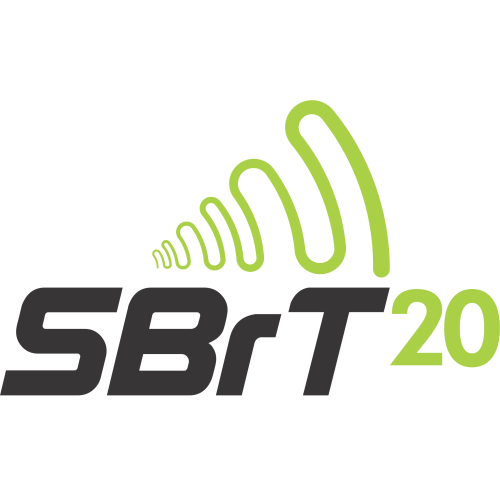
XXXVIII Simpósio Brasileiro de Telecomunicações e Processamento de Sinais

Transmissão de energia no interferômetro de Mach-Zehnder de fibra de cristal fotônico com modulação PWM
Antonio Alan Rodrigues de Araújo, Francisco Araujo, Lorenna Araujo, Iara Sousa, Vanessa Alves
DOI: 10.14209/SBRT.2020.1570661424
Keywords: fibra de cristal fotônico acoplador direcional não linear modulação por largura de pulso controle de fase
Abstract
This paper presents a study about the operation of a fully optical device based on nonlinear directional couplers based on crystal fiber dual-core. It analyzed the transmission and interaction of energy between the pulses of the waveguides through pulse width modulation, taking into account the input power, pulse modulation and phase difference. The numerical study used the Runge-Kutta fourth order to solve the pair of coupled mode equations considering the nonlinear effects of selfphase modulation, cross phase modulation, Raman intrapulse, selfsteepening. In addition to the linear effects of second and third order dispersion.Download
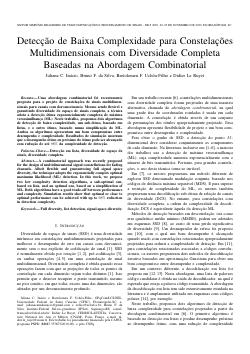
Detecção de Baixa Complexidade para Constelações Multidimensionais com Diversidade Completa Baseadas na Abordagem Combinatorial
Juliana C Inácio, Bruno Fontana da Silva, Bartolomeu F. Uchôa-Filho, Didier Le Ruyet
DOI: 10.14209/SBRT.2020.1570661427
Keywords: detecção em lista diversidade de espaço de sinais diversidade completa
Abstract
A combinatorial approach was recently proposed for the design of multidimensional signal constellations for fading channels. Albeit flexible and guaranteeing full signal space diversity, the technique adopts the exponentially complex optimal maximum likelihood (ML) detection. In this work, we propose two low complexity detection algorithms, a sub-optimal one, based on lists, and an optimal one, based on a simplification of ML. Both algorithms have a good trade-off between performance and complexity. Simulation results show that optimal or close to optimal performance can be achieved with up to 92% reduction in detection complexity.Download
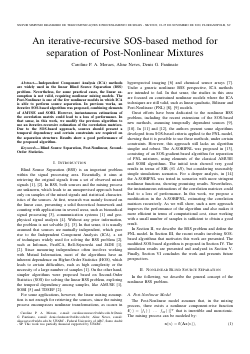
An iterative-recursive SOS-based method for separation of Post-Nonlinear Mixtures
Caroline P. A. Moraes, Aline Neves, Denis Fantinato
DOI: 10.14209/SBRT.2020.1570661430
Keywords: Blind Source Separation Post-Nonlinear Second-Order Statistics
Abstract
Independent Component Analysis (ICA) methods are widely used in the linear Blind Source Separation (BSS) problem. Nevertheless, for some practical cases, the linear assumption is not valid, requiring nonlinear mixing models. The Post-Nonlinear is one of the few nonlinear models in which ICA is able to perform source separation. In previous works, an iterative SOS-based algorithm was proposed, combining elements of AMUSE and SOBI. However, instantaneous estimations of the correlation matrix could lead to a loss of performance. In that sense, in this work, we modify the previous algorithm to use an iterative-recursive estimation of the correlation matrices. Due to the SOS-based approach, sources should present a temporal dependency and certain constraints are required on the separation structure. Results show a good performance of the proposed algorithm.Download
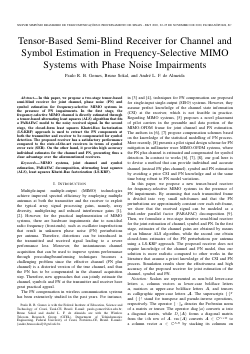
Tensor-Based Semi-Blind Receiver for Channel and Symbol Estimation in Frequency-Selective MIMO Systems with Phase Noise Impairments
Paulo Gomes, Bruno Sokal, André de Almeida
DOI: 10.14209/SBRT.2020.1570661432
Keywords: MIMO systems joint channel and symbol estimation PARAFAC decomposition
Abstract
In this paper, we propose a two-stage tensor-based semi-blind receiver for joint channel, phase noise (PN) and symbol estimation for frequency-selective MIMO systems in the presence of PN impairments. In the first stage, the frequency-selective MIMO channel is directly estimated through a tensor-based alternating least squares (ALS) algorithm that fits a PARAFAC model to the noisy received signal. In the second stage, the closed-form least squares Khatri-Rao factorization (LS-KRF) approach is used to extract the PN components at both the transmitter and receiver to be compensated for symbol detection. The proposed receiver has a satisfactory performance compared to the state-of-the-art receivers in terms of symbol error rate (SER). On the other hand, it provides high accuracy individual estimates for the channel and PN, presenting thus a clear advantage over the aforementioned receivers.Download
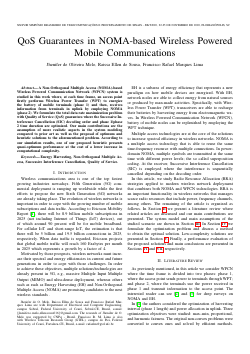
QoS Guarantees in NOMA-based Wireless Powered Mobile Communications
Jhenifer de Oliveira Melo, Raissa de Sousa, Francisco Rafael Marques Lima
DOI: 10.14209/SBRT.2020.1570661435
Keywords: Energy Harvesting Non-Orthogonal Multiple Access Successive Interference Cancellation Quality of Service
Abstract
A Non-Orthogonal Multiple Access (NOMA)-based Wireless Powered Communication Network (WPMC) system is studied in this work where, at each time frame, an access point firstly performs Wireless Power Transfer (WPT) to energize the battery of mobile terminals (phase 1) and then, receives information from terminals in uplink by employing NOMA (phase 2).We formulate the total data rate maximization problem with Quality of Service (QoS) guarantees where the Successive Interference Cancellation (SIC) decoding order and phase 1/phase 2 time duration are optimized. Our main contributions are the assumption of more realistic aspects in the system modeling compared to prior art as well as the proposal of optimum and heuristic solutions to the aforementioned problem. According to our simulation results, one of our proposed heuristic presents quasi-optimum performance at the cost of a lower increase in computational complexity.Download
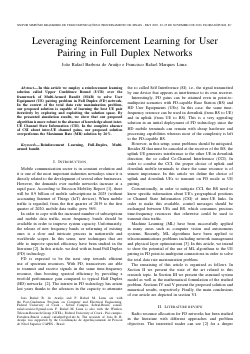
Leveraging Reinforcement Learning for User Pairing in Full Duplex Networks
João Rafael Barbosa de Araujo, Francisco Rafael Marques Lima
DOI: 10.14209/SBRT.2020.1570661436
Keywords: Reinforcement Learning Full-Duplex Multiarmed bandit
Abstract
In this article we employ a reinforcement learning solution called Upper Confidence Bound (UCB) over the framework of Multi-Armed Bandit (MAB) to solve User Equipment (UE) pairing problem in Full Duplex (FD) network. In the context of the total data rate maximization problem, our proposed solution is capable of learning the best UE pair iteratively by exploring and exploiting the solution space. By the presented simulation results, we show that our proposed algorithm is more robust to the absence of knowledge about inter-UE Channel State Information (CSI). In the complete absence of CSI about inter-UE channel gains, our proposed solution overperforms the Maximum Rate (MR) solution by 26%.Download

Uso de Estratégias de Multiplicação por Múltiplas Constantes para Implementação de Filtros Volterra
Eduardo L. O. Batista, Rogério Paludo
DOI: 10.14209/SBRT.2020.1570661463
Keywords: Filtro Volterra FPGA MCM
Abstract
This work is focused on the development of a new effective strategy to implement Volterra filters using flexible or configurable hardware platforms such as field-programmable gate arrays (FPGAs). The proposed strategy is based on multiple-constant-multiplication (MCM) techniques, which utilize shifts, sums, and hardware reuse for effectively carrying out multiplications by constants. A transposed implementation for Volterra kernels is also introduced in this work aiming to further enhance the results obtained using MCM techniques. Experimental results demonstrate the effectiveness of the proposed strategy.Download
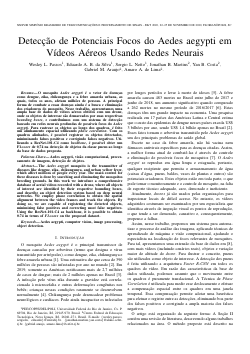
Detecção de Potenciais Focos do Aedes aegypti em Vídeos Aéreos Usando Redes Neurais
Wesley Passos, Eduardo A. B. da Silva, Sergio Lima Netto, Jonathan B. Martins, Yan B. Costa, Gabriel Araujo, Amaro de Lima
DOI: 10.14209/SBRT.2020.1570661555
Keywords: Aedes aegypti visão computacional processamento de imagem detecção de objetos
Abstract
The Aedes aegypti mosquito is the transmitter of diseases like dengue, zika, chikungunya, and urban yellow fever, which affect millions of people every year. The main control for these diseases is done by searching and eliminating the mosquitos breeding grounds. In this work we introduce a comprehensive database of aerial videos recorded with a drone, where all objects of interest are identified by their respective bounding boxes, and describe an object detection system based on deep neural networks. We employ phase correlation to obtain the spatial alignment between the video frames and track the objects. By doing so, we are capable of registering the detected objects, minimizing false positives and correcting most false negatives. Using the ResNet-101-C4 as backbone, it is possible to obtain 0.74 in terms of F1-score on the proposed dataset.Download
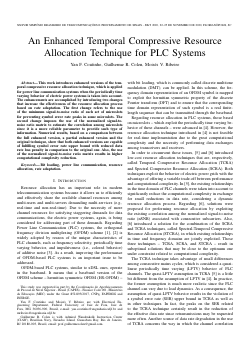
An Enhanced Temporal Compressive Resource Allocation Technique for PLC Systems
Yan F Coutinho, Guilherme Colen, Moises Vidal Ribeiro
DOI: 10.14209/SBRT.2020.1570661574
Keywords: Bit loading Power Line Communication resource allocation rate adaptive
Abstract
This work introduces enhanced versions of the temporal compressive resource allocation technique, which is applied for power line communication systems when the periodically time varying behavior of electric power systems is taken into account. The enhancements are accomplished by introducing two changes that increase the effectiveness of the resource allocation process based on rate adaptation. The first change refers to the use of the minimum signal-to-noise ratio of each set of microslots for preventing symbol error rate peaks in some microslots. The second change imposes the use of the normalized signal-to-noise ratio matrix to estimate the correlation among microslots since it is a more reliable parameter to provide such type of information. Numerical results, based on a comparison between the full enhanced version, a partial enhanced version and the original technique, show that both enhanced versions are capable of fulfilling symbol error rate upper bound with reduced data rate loss penalty in comparison to the original one. Also, the use of the normalized signal-to-noise ratio matrix results in higher computational complexity reduction.Download
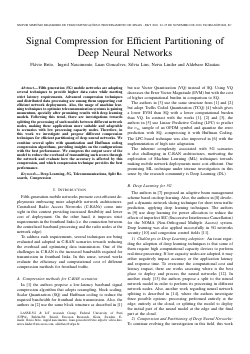
Signal Compression for Efficient Partitioning of Deep Neural Networks
Flavio Mendes de Brito, Ingrid Nascimento, Luan Assis Gonçalves, Silvia Lins, Neiva Linder, Aldebaro Klautau
DOI: 10.14209/SBRT.2020.1570661586
Keywords: Deep Learning 5G Telecommunications Split Research
Abstract
Fifth generation (5G) mobile networks are adopting several techniques to provide higher data rates while meeting strict latency requirements. Advanced compression techniques and distributed data processing are among them supporting cost efficient network deployments. Also, the usage of machine learning techniques to optimize telecommunication systems is gaining momentum, specially after promising results with deep learning models. Following this trend, there are investigations towards splitting the processing of such models between different network nodes, making these applications more suitable and adaptable to scenarios with low processing capacity nodes. Therefore, in this work we investigate and propose different compression techniques for efficient partitioning of deep neural networks. We combine several splits with quantization and Huffman coding compression algorithms, providing insights on the configurations with the best performance. We compress the output score of the model to reduce the overhead of transmitting such scores through the network and evaluate how the accuracy is affected by this compression, and which compression technique provides the best performance.Download